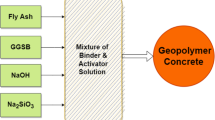Abstract
In the present study, compressive strength of lightweight aluminosilicate geopolymers produced by fine fly ash and rice husk bark ash together with palm oil clinker (POC) aggregates has been modeled by gene expression programming. To build the model, training and testing by using experimental results from 144 specimens were conducted. The used data in the models are arranged in a format of six input parameters that cover the quantity of fine POC particles, the quantity of coarse POC particles, the quantity of FA + RHBA mixture, the ratio of alkali activator to ashes mixture, the age of curing, and the test trial number. According to these input parameters, in the gene expression programming models, the compressive strength of each specimen was predicted. The best value of R2 and the minimum values of root mean square error (RMSE) and absolute percentage error (MAPE) are 0.9669, 2.583, and 1.984, respectively, all in training phase. The minimum value of R2 and the maximum values of RMSE and MAPE are 0.9456, 3.067, and 2.356, respectively, all in testing phase. The training and testing results in the models have shown a strong potential for predicting the compressive strength of the lightweight geopolymer specimens in the considered range and one may predict them with a tiny error.






Similar content being viewed by others
Change history
15 April 2020
The Editor-in-Chief has retracted this article because it significantly overlaps with a number of articles including those that were under consideration at the same time and previously published articles. Additionally, the article shows evidence of peer review manipulation. The author has not responded to any correspondence regarding this retraction.
References
Tailby J, MacKenzie KJD (2010) Structure and mechanical properties of aluminosilicate geopolymer composites with Portland cement and its constituent minerals. Cem Concrete Res 40:787–794
Pimraksaa K, Chindaprasirt P, Rungchet A, Sagoe-Crentsil K, Sato T (2011) Lightweight geopolymer made of highly porous siliceous materials with various Na2O/Al2O3 and SiO2/Al2O3 ratios. Mater Sci Eng, A 528:6616–6623
Mohammed BS, Al-Ganad MA, Abdullahi M (2011) Analytical and experimental studies on composite slabs utilising palm oil, clinker concrete. Constr Build Mater 25:3550–3560
Nazari A, Riahi S, Bagheri A (2012) Designing water resistant lightweight geopolymers produced from waste materials. Mater Des 35:296–302
Nazari A, Khalaj G (2012) Prediction compressive strength of lightweight geopolymers by ANFIS. Ceram Int 38:4501–4510
Nazari A (2012) Fuzzy logic for prediction water absorption of lightweight geopolymers produced from waste materials. Ceram Int 38:4729–4736
Nazari A (2012) Utilizing ANFIS for prediction water absorption of lightweight geopolymers produced from waste materials. Neural Comput Appl. doi:10.1007/s00521-012-0934-1
Nazari A (2012) Artificial neural networks application to predict the compressive damage of lightweight geopolymer. Neural Comput Appl. doi:10.1007/s00521-012-0945-y
Cevik A, Sonebi M (2009) Genetic programming based formulation for fresh and hardened properties of self-compacting concrete containing pulverised fuel ash. Constr Build Mater 23(7):2614–2622
Milani AA, Nazari A (2012) Modeling Ductile-to-Brittle transition temperature of functionally graded steels by gene expression programming. Int J Damage Mech 21(4):465–492
Nazari A, Khalaj G, Didehvar N (2012) Computational investigations of the impact resistance of aluminum-epoxy laminated composites. Int J Damage Mech 21(5):623–646
Cevik A, Guzelbey İH (2007) A soft computing based approach for the prediction of ultimate strength of metal plates in compression. Eng Struct 29(3):383–394
Cevik A, Sonebi M (2008) Modelling the performance of self-compacting SIFCON of cement slurries using genetic programming technique. Comput Concrete 5:475–490
Cevik A (2007) A new formulation for longitudinally stiffened webs subjected to patch loading. J Constr Steel Res 63:1328–1340
Nazari A (2012) Experimental study and computer-aided prediction of percentage of water absorption of geopolymers produced by waste fly ash and rice husk bark ash. Int J Min Process 110–111:74–81
Koza JR (1992) Genetic programming: on the programming of computers by means of natural selection. MIT Press, Cambridge
Rosenblatt F (1962) Principles of neuro dynamics: perceptrons and the theory of brain mechanisms. Spartan Books, Washington
Rumelhart DE, Hinton GE, William RJ (1986) Learning internal representation by error propagation. In: Rumelhart DE, McClelland JL (eds) Proceeding parallel distributed processing foundation, vol 1. MIT Press, Cambridge
Liu SW, Huang JH, Sung JC, Lee CC (2002) Detection of cracks using neural networks and computational mechanics. Comput Meth Appl Mech Eng 191(25–26):2831–2845
Anderson JA (1983) Cognitive and psychological computation with neural models. IEEE Trans Syst Man Cybern, V.SMC-13 5:799–814
Hopfield JJ (1982) Neural networks and physical systems with emergent collective computational abilities. Proc Nat Acad Sci 79:2554–2558
Topcu IB, Sarıdemir M (2008) Prediction of compressive strength of concrete containing fly ash using artificial neural network and fuzzy logic. Comp Mater Sci 41(3):305–311
Author information
Authors and Affiliations
Corresponding author
Additional information
The Editor-in-Chief has retracted this article because it significantly overlaps with a number of articles including those that were under consideration at the same time and previously published articles. Additionally, the article shows evidence of peer review manipulation. The author has not responded to any correspondence regarding this retraction.
About this article
Cite this article
Nazari, A. RETRACTED ARTICLE: Application of gene expression programming to predict the compressive damage of lightweight aluminosilicate geopolymer. Neural Comput & Applic 31 (Suppl 2), 767–776 (2019). https://doi.org/10.1007/s00521-012-1137-5
Received:
Accepted:
Published:
Issue Date:
DOI: https://doi.org/10.1007/s00521-012-1137-5




